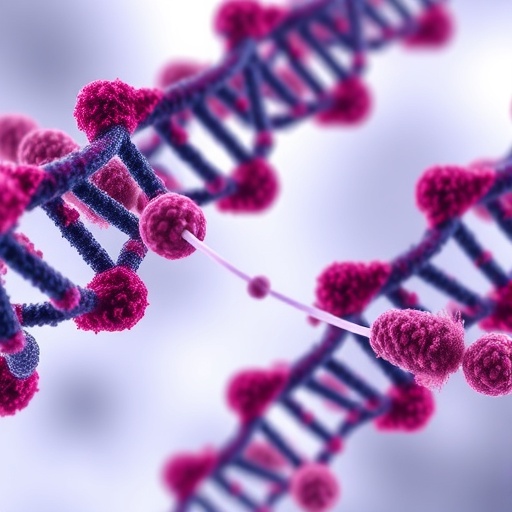A groundbreaking study recently published in Nature unveils a novel and transformative mechanism by which cells avoid self-inflicted immune responses through a sophisticated chemical modification of RNA. Spearheaded by Ryan Flynn, MD, PhD, in collaboration with Vijay Rathinam, DVM, PhD, and graduate student Vincent Graziano from UConn Health, alongside researchers at Boston Children’s Hospital, this work elucidates the role of RNA N-glycosylation in immune evasion and opens intriguing new avenues to understand autoimmune disease development and pathogen detection. The impact of this discovery is poised to revolutionize our grasp of innate immunity at the molecular level.
Innate immune sensing of RNA stands as a pivotal defensive strategy enabling the body to mount rapid responses against invading pathogens. However, RNA itself is not inherently recognized as a pathogen-specific molecular signature, posing a complex challenge: the immune system must distinguish between foreign RNAs and its own self-RNA to prevent harmful autoimmune reactions. To navigate this fine balance, cells employ numerous biochemical modifications to camouflage self-RNA, preventing aberrant immune activation. Among these myriad modifications, N-glycosylation of RNA, a recently revealed post-transcriptional alteration, has remained enigmatic concerning its function — until now.
N-glycosylation is a classical form of protein modification where sugar molecules called glycans are enzymatically attached to nitrogen atoms within molecules, historically well-characterized on proteins but long thought absent from RNA chemistry. The seminal discovery by Ryan Flynn’s lab, in conjunction with Nobel laureate Carolyn Bertozzi, overturned this dogma by identifying ‘glycoRNAs’: small RNAs modified with sialic acid-containing, N-linked glycans. These glycated RNAs uniquely localize to the cell surface, a striking phenomenon for nucleic acids traditionally confined within cells. Yet, the question persisted—what role does this glycosylation serve, and why are glycoRNAs tolerated on the cell membrane without triggering immune alarms?
.adsslot_bgynCvu3Qk{width:728px !important;height:90px !important;}
@media(max-width:1199px){ .adsslot_bgynCvu3Qk{width:468px !important;height:60px !important;}
}
@media(max-width:767px){ .adsslot_bgynCvu3Qk{width:320px !important;height:50px !important;}
}
ADVERTISEMENT
The new research answers this vital question by revealing that N-glycans on glycoRNAs function as molecular “cages.” Specifically, these sugar moieties shield a hypermodified RNA nucleobase known as acp^3U (3-(3-amino-3-carboxypropyl)uridine), which is inherently immunostimulatory if exposed. The study shows that the acp^3U base is the endogenous site for this RNA N-glycosylation, confirming earlier observations by the Flynn lab (PMID: 39173631). By masking acp^3U, the glycans effectively conceal a molecular beacon that otherwise would alert innate immune sensors, preventing autoinflammatory responses during normal physiological functions.
This biochemical cloaking mechanism explains how glycoRNAs persist on the cell surface and within endosomal compartments without precipitating innate immune activation, a feat that challenges our earlier simplistic models of immune surveillance. The researchers demonstrated that when the glycan “cage” is removed or disrupted, the acp^3U-laden RNA elicits strong innate immune responses, elucidating a fundamental cellular immune evasion strategy. This insight bridges a critical knowledge gap in RNA biology and immunology, highlighting the nuanced interplay between RNA modifications and host defense mechanisms.
Moreover, the implications of this discovery extend beyond immune evasion. The regulatory role of RNA N-glycosylation could profoundly affect homeostatic efferocytosis—the process by which dying cells are cleared without inflammatory consequences. Given that improper clearance triggers autoimmunity and chronic inflammation, the role of glycoRNAs and their glycan shields may prove seminal in maintaining immune tolerance at tissue interfaces where cellular turnover is continuous and high.
These findings also prompt pressing questions regarding the pathogenesis of autoimmune diseases such as systemic lupus erythematosus (SLE), where innate immune sensors are hyperactivated by self-RNA. Could aberrations in RNA N-glycosylation or defects in glycoRNA processing contribute to the breakdown of self-tolerance? Unraveling this could pave the way for novel diagnostic biomarkers or therapeutic interventions targeting the glycosylation pathways implicated in autoimmune flare-ups.
On a cellular and molecular level, the study describes how the intricate enzymatic machinery responsible for N-glycosylation co-opts RNA substrates traditionally neglected by glycosyltransferases. This cross-talk between canonical protein glycosylation pathways and RNA metabolism unveils an unexpected layer of post-transcriptional regulation. Identifying the enzymes involved and understanding their specificity within the context of RNA glycosylation stands as a new frontier for research into cellular homeostasis and immune regulation.
The localization of glycoRNAs to the cell surface adds another dimension of complexity. Surface-expressed nucleic acids were famously considered aberrant signals of cellular distress or infection. This work suggests that glycoRNAs represent a controlled, physiologic state of extracellular RNA, expanding our conceptions of cell surface biochemistry. Future studies into how immune cells perceive glycoRNAs and whether these molecules participate in intercellular communication or modulation of immune checkpoints remain highly anticipated.
Additionally, the revelation that N-glycans on RNA serve as immune cloaks highlights the sophisticated chemical versatility of RNA, traditionally viewed mostly through the lens of base pairing and coding functions. The covalent decoration of RNA with complex glycans underscores its multifunctional roles beyond genetic information carriers, positioning RNA modifications as pivotal players in immune signaling and regulation.
This pioneering research not only challenges existing paradigms regarding nucleic acid immunogenicity but also integrates glycoscience into RNA biology, immunology, and cell physiology with profound translational potential. By delineating the molecular basis by which RNA glycosylation mediates immune evasion and facilitates efferocytosis, the study sets the stage for developing RNA-targeted therapeutics that harness or modulate these glycosylation pathways to treat autoimmune and inflammatory diseases.
The multidisciplinary collaboration between experts in RNA biochemistry, immunology, and glycobiology underscores the complexity of the cellular processes unraveled in this study. Their collective expertise enabled the characterization of glycoRNAs’ biochemical properties, immune functions, and biological localizations, providing a robust framework for future investigations into RNA modifications as regulators of immune homeostasis.
In sum, this breakthrough research redefines the landscape of innate immune recognition, illuminating how N-glycosylation of RNA serves as a molecular stealth mechanism preventing self-RNA from triggering immune activation. This finding holds promise for revolutionizing our understanding of immune tolerance, autoimmunity, and the development of innovative therapies that target the glycobiology of RNA to modulate immune responses with precision.
Subject of Research: The role of RNA N-glycosylation in innate immune evasion and homeostatic efferocytosis.
Article Title: RNA N-glycosylation enables immune evasion and homeostatic efferocytosis
News Publication Date: 6-Aug-2025
Web References:
http://dx.doi.org/10.1038/s41586-025-09310-6
References:
Prior discovery of glycoRNAs and identification of endogenous N-glycosylation site acp^3U (PMID: 39173631)
Keywords:
Glycosylation, RNA, Glycobiology, Innate immune response
Tags: autoimmune disorder mechanismsbiochemical modifications of RNAimmune evasion strategiesinnate immune responsesmolecular biology of autoimmune diseasesN-glycosylation in immunitypost-transcriptional RNA alterationsresearch on immune system functionRNA and pathogen detectionRNA modificationsself-RNA recognitionUConn Health collaborative studies





